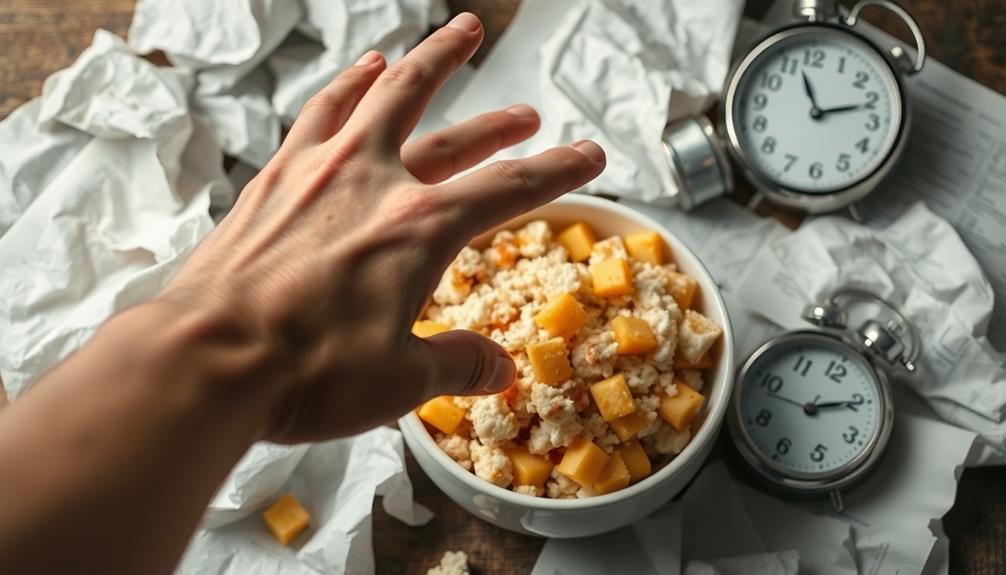Food cravings are intense desires for specific foods, often unrelated to physical hunger. You might crave certain snacks due to hormonal shifts, emotional states, or even environmental triggers. Stress can elevate cortisol levels, pushing you towards high-calorie comfort foods. Lack of sleep can exacerbate cravings by disrupting hormone balance. Additionally, food marketing plays a big role, as hyperpalatable options are hard to resist. Understanding these factors can help you manage your cravings. There's more to learn about how to navigate these desires and make healthier choices that align with your goals.
Key Takeaways
- Food cravings are intense desires for specific foods, often influenced by emotional states, stress, and hormonal changes rather than physical hunger.
- Hormones like cortisol, leptin, and ghrelin play crucial roles in regulating cravings, particularly during stress and sleep deprivation.
- Psychological triggers such as emotional distress and learned behaviors can intensify cravings, leading to comfort food consumption.
- Food addiction affects a significant portion of the population, sharing similarities with substance abuse and complicating efforts to manage cravings.
- Strategies like staying hydrated, maintaining a consistent eating schedule, and removing trigger foods can help manage cravings effectively.
Definition of Food Cravings

What exactly are food cravings? They're intense desires for specific foods, often driven more by emotional states than by physical hunger. Over 90% of you'll experience food cravings at some point, influenced by factors like stress and hormonal changes.
These cravings can arise from external cues, such as seeing a delicious dessert, or internal cues, like feeling sad or overwhelmed. Curiously, cravings can also be influenced by cultural factors, where certain cuisines, like Chinese cuisine, evoke strong emotional connections and cravings for comfort foods, such as Red-Braised Pork Belly or Sichuan Cold Noodles.
You might notice that cravings vary based on gender differences; males often lean towards savory foods, while females typically crave high-fat, sweet options. This variation highlights how personal and complex these desires can be.
The experience of food cravings is closely tied to brain activity, particularly in areas associated with reward processing. Your brain's neurobiological response to cravings makes them feel almost irresistible at times.
Understanding what drives your food cravings can help you manage them better. Instead of giving in to every urge, you can recognize when cravings stem from emotional triggers rather than true hunger.
Hormonal Influences on Cravings

Hormones greatly influence your food cravings, often dictating what you crave and when. Various hormones interact to regulate your appetite and cravings, and disruptions can lead to persistent desires for certain foods. For instance, cravings may be influenced by cultural preferences, such as the popularity of dishes like Mushroom Masala among vegetarians.
Here are three key hormones to evaluate:
- Cortisol: Elevated during chronic stress, it can trigger cravings for high-fat and calorie-dense foods.
- Leptin and Ghrelin: Sleep deprivation decreases leptin, which suppresses appetite, while increasing ghrelin, the hunger hormone, leading to stronger cravings for unhealthy foods.
- Insulin: Fluctuations in insulin levels can affect your cravings, especially for sugary foods.
Additionally, hormonal fluctuations during your menstrual cycle can cause specific cravings for sweet and high-fat foods.
If you're taking certain medications, like antidepressants or steroids, these can also disrupt normal hunger signaling, increasing cravings for specific types of food.
Understanding these hormonal influences can help you manage your appetite and cravings more effectively, allowing for healthier choices. Recognizing how cortisol, leptin, and ghrelin work together can empower you to take charge of your eating habits.
Psychological Triggers of Cravings

Food cravings often arise from psychological triggers that go beyond physical hunger. When you're feeling emotional states like stress, boredom, or sadness, you might find yourself reaching for comfort foods as a way to cope.
These cravings aren't just about hunger; they often stem from learned behaviors tied to your past experiences with food. For instance, the sight of a favorite snack or an enticing advertisement can condition your mind to crave those foods, even when you're not hungry. Notably, the flavors and textures of traditional dishes, such as Brazilian cuisine, can evoke strong memories and emotions, intensifying these cravings.
Restrictive dieting can amplify these cravings, creating a psychological impact that makes you yearn for the very foods you're avoiding. Studies show that when you deprive yourself of certain foods, cravings increase, particularly later in the day.
This cycle can become a struggle, as the pressure of food restriction makes those cravings harder to resist.
Your eating patterns are often influenced by these psychological triggers, leading to a complex relationship with food. Understanding this connection can help you navigate cravings more effectively, allowing you to make mindful choices rather than falling into habitual responses driven by emotional states.
The Role of Stress

Stress often manifests as a powerful influence on your eating habits, leading to intense cravings for high-calorie, comfort foods. When you're stressed, your body releases cortisol, which stimulates appetite and drives you toward emotional eating.
Additionally, you might find yourself gravitating towards nourishing, seasonal dishes, such as Nettle and Potato Soup, which can provide comfort and essential nutrients. This cycle can exacerbate your food cravings and even result in weight gain, further deepening your stress. It’s important to remain mindful of how you prepare these comforting meals, as **nutrient loss in different cooking methods** can affect the overall benefit of the dish. Opting for gentle cooking techniques like steaming or light sautéing can help preserve the nutritional value of key ingredients. By being intentional with both what you eat and how it’s cooked, you can better support your body during times of heightened stress.
Here are three key points to reflect on about stress and cravings:
- Carbohydrate Cravings: Under stress, you may crave carbohydrate-rich foods that temporarily boost serotonin levels, enhancing your mood.
- Sleep Deprivation Effects: Stress often disrupts sleep, leading to hormonal imbalance. Increased ghrelin (the hunger hormone) and decreased leptin (the satiety hormone) heighten your appetite and cravings.
- Stress Management Techniques: Incorporating practices like mindfulness and physical activity can help manage stress, reducing the emotional triggers behind your cravings.
Impact of Sleep on Cravings

Sleep plays an important role in regulating your cravings, and inadequate rest can lead to a cascade of physiological changes. Chronic sleep deprivation increases levels of the hunger hormone ghrelin while decreasing the satiety hormone leptin. This imbalance heightens your appetite and intensifies food cravings, particularly for unhealthy snacks.
| Effect of Sleep Deprivation | Impact on Cravings |
|---|---|
| Increased Ghrelin Levels | Higher hunger and cravings |
| Decreased Leptin Levels | Reduced feeling of fullness |
| Less Than 7 Hours of Sleep | Greater cravings for snacks |
| Cravings for Carbohydrates | Preference for high-calorie foods |
| Poor Sleep Quality | Difficulty in appetite regulation |
Studies reveal that individuals who sleep less than seven hours a night tend to consume more unhealthy snacks. Furthermore, after just one week of insufficient sleep, cravings for snacks, especially high in carbohydrates and fats, greatly increase. To combat these cravings, it's essential to enhance sleep quality and duration, helping restore hormonal balance. Prioritizing restful sleep can effectively reduce the frequency and intensity of your food cravings.
Food Addiction Explained

When you think about cravings and eating behaviors, it's vital to recognize that food addiction can greatly impact your relationship with food. This condition shares similarities with substance abuse disorders, affecting about 20% of the general population, especially women over 35 and those with obesity.
Food addiction manifests through cravings, tolerance, and withdrawal symptoms, making it challenging to resist hyperpalatable foods. For instance, festive gatherings often feature tempting treats like Graveyard Taco Dip, which can exacerbate cravings during special occasions.
To better understand food addiction, consider these key points:
- Assessment: The Yale Food Addiction Scale (YFAS) helps identify addictive-like eating behaviors, highlighting the change from impulsive to compulsive eating.
- Neurological Impact: Food addiction activates dopamine pathways in your brain, similar to drug addiction, which complicates your ability to quit certain foods.
- Eating Disorders: Approximately 58% of individuals with diagnosed eating disorders also experience food addiction, demonstrating the overlap between these conditions.
Understanding food addiction is essential for addressing cravings and developing healthier eating habits. By recognizing these patterns, you can work towards a better relationship with food and combat impulsive eating behaviors effectively.
Hyperpalatable Foods and Marketing

Hyperpalatable foods have taken over our diets, thanks in large part to clever marketing strategies that target our cravings. These foods, loaded with sugar, fat, and salt, activate dopamine pathways in your brain, making them difficult to resist.
The food industry spends over $10 billion annually on snack food advertising, greatly shaping your dietary behaviors, especially if you're young. Traditional dishes like Muamba De Galinha or Kitfo reflect how diverse and rich global cuisines can be, yet they often compete with processed foods in our daily choices.
Research indicates that increased exposure to these ads correlates with higher calorie intake and a greater tendency to choose unhealthy options. This relentless marketing can lead to poor dietary habits and a heightened risk of obesity, particularly among children and adolescents.
The prevalence of food addiction, which shares traits with the compulsive nature of hyperpalatable foods, affects around 20% of the general population and climbs to about 58% among those with eating disorders.
As you navigate a world filled with enticing ads for these processed snacks, it's vital to recognize how marketing influences your food cravings and choices. Understanding this connection can empower you to make healthier decisions in an environment designed to promote unhealthy eating. Many advertisements strategically highlight convenience and flavor while downplaying the excessive amounts of sugars, unhealthy fats, or additives such as MSG found in these products. It’s essential to be aware of the truth about MSG and other flavor enhancers that can make processed foods more addictive, contributing to overeating. By staying informed and consciously choosing whole, nutrient-dense foods, you can take control over your diet and resist the pull of manipulative marketing tactics. Additionally, being mindful of ingredient labels allows you to spot hidden additives and make more informed decisions. Educating yourself on the **truth about MSG** and other potentially harmful ingredients helps you critically assess the foods you’re consuming. In doing so, you can prioritize nourishing options that support long-term health rather than falling prey to convenience-driven, highly processed alternatives.
Strategies to Manage Cravings

Managing cravings can feel like an uphill battle, but implementing effective strategies can make a notable difference. To help you manage cravings, consider these three approaches:
1. Stay Hydrated: Drinking water can help differentiate between hunger and thirst, reducing the urge for unhealthy snacks. Aim to drink water regularly throughout the day.
Additionally, enjoying traditional Indonesian desserts like Kue Putu, which are naturally sweetened with palm sugar, may satisfy your sweet tooth in a healthier way.
2. Develop a Consistent Eating Schedule: Eating balanced meals every 3-4 hours can prevent excessive hunger and keep cravings at bay. Focus on meals rich in protein and fiber to promote satiety, which will help you feel fuller for longer.
Incorporating dishes such as Nasi Tumpeng can provide a colorful and nutritious option to keep you satisfied.
3. Engage in Physical Activities: Incorporating regular physical activities, like a brisk walk, can distract you from cravings while boosting your mental well-being.
Additionally, identify and remove trigger foods from your home environment. By keeping these out of sight, you noticeably decrease the likelihood of experiencing food cravings.
Implementing these strategies can lead to better management of hunger and cravings, ultimately supporting your health goals.
Healthier Food Alternatives

When cravings hit, choosing healthier food alternatives can make a big difference in how you feel.
Instead of reaching for chips or candy, consider swapping them out for air-popped popcorn or dark chocolate.
You might also enjoy some traditional Horiatiko Psomi (Country Bread), which is a wholesome and hearty option that can satisfy your hunger while providing essential nutrients.
You'll satisfy your cravings while nourishing your body with better options.
Nutritious Snack Swaps
Often, the snack choices we make can greatly impact our overall health. By swapping in more nutritious options, you can satisfy your cravings while keeping your calorie and sugar intake in check.
For instance, incorporating traditional Japanese snacks like Dorayaki (Red Bean Pancake) can provide a delicious yet healthier way to indulge in sweets without excess calories.
Here are three healthier snack swaps to reflect on:
- Air-popped popcorn instead of potato chips: This crunchy alternative not only satisfies your need for something crispy but also has considerably fewer calories and less fat.
- Dark chocolate (70% cocoa or higher) instead of milk chocolate: If you're craving something sweet, dark chocolate offers a richer flavor with less sugar, making it a more satisfying choice.
- Fresh or dried fruits instead of sugary snacks: Fruits provide essential vitamins and fiber while cutting down on added sugars. They're a sweet, nutritious way to curb your cravings.
Sweet Alternatives Options
Finding healthier sweet alternatives can make a significant difference in your diet without sacrificing flavor. When those sweet cravings hit, consider fresh fruits instead of sugary snacks. They provide natural sweetness along with essential vitamins, minerals, and fiber, helping you satisfy your cravings healthily.
For instance, a turkey sandwich can be a delightful way to use leftover turkey and add a touch of sweetness with cranberry sauce, making it a nutritious option that combines savory and sweet leftover turkey recipes.
If you're a chocolate lover, dark chocolate with at least 70% cocoa content is a great option. It offers antioxidants and has less sugar than milk chocolate, making it a satisfying choice for your sweet tooth.
For a crunchy snack, try air-popped popcorn seasoned with a small amount of salt. It's low in calories and a good alternative to high-calorie, sugary treats.
Yogurt with added fruit or a drizzle of honey can serve as a nutritious substitute for ice cream, packed with probiotics and protein while avoiding excessive sugar and fat.
Additionally, sparkling water flavored with a splash of fruit juice can replace sugary sodas. This rejuvenating choice delivers taste without the added sugars and calories.
Savory Choices Recommendations
Craving something savory doesn't have to mean reaching for unhealthy snacks. Instead of indulging in calorie-dense processed foods, you can choose delicious alternatives that provide nutritional balance while satisfying your food cravings.
Here are three tasty substitute options to contemplate:
- Nuts or Air-Popped Popcorn: Swap out potato chips for salted nuts or air-popped popcorn. These snacks offer healthy fats and fiber, while being lower in sodium and calories.
- Low-Fat Cheese or Nutritional Yeast: Instead of traditional cheese, try low-fat or low-sodium varieties, or sprinkle some nutritional yeast on your meals. It adds a cheesy flavor without the saturated fat.
- Whole-Grain Crackers with Hummus: When you want something more filling, opt for whole-grain crackers paired with hummus or guacamole. This combo delivers a nutritious balance of fiber, healthy fats, and protein.
You don't have to compromise on flavor for health. By making these simple swaps, you can enjoy savory foods that keep your cravings in check while maintaining a healthy lifestyle.
Long-Term Habit Changes

Making long-term habit changes is essential for managing food cravings effectively. Start by incorporating balanced meals every 3-4 hours to stabilize your blood sugar levels. This approach not only keeps hunger at bay but also helps reduce cravings.
Engaging in physical activities, like walking or exercising, can distract you from cravings while promoting healthier eating behaviors over time.
It's important to minimize exposure to environmental cues that trigger cravings. For instance, avoiding keeping trigger foods at home can greatly decrease how often you feel the urge to indulge.
Implementing stress management strategies, such as mindfulness practices or relaxation techniques, will also play a critical role. These methods can help you prevent emotional eating, which often leads to unhealthy choices.
Frequently Asked Questions
What Is the Scientific Reason Behind Cravings?
Cravings arise from complex brain activity, influenced by emotions, stress, and environmental cues. Your body's hormonal balance and external triggers can heighten these desires, often leading you to seek out sugary and fatty foods for comfort.
What Is the Psychology Behind Food Cravings?
You think you want that chocolate cake, right? But it's really your emotions pulling strings. Stress, memories, and those pesky cues in your environment trigger cravings, making you crave comfort over kale. Isn't psychology fun?
What Is the Biological Cause of Food Cravings?
Food cravings stem from complex biological mechanisms in your brain and body. Hormones like insulin and ghrelin influence your hunger signals, while brain regions trigger desires for specific foods, especially when you're stressed or sleep-deprived.
What Is the Mechanism of Food Cravings?
Ever noticed how a sweet treat pulls you in? Your brain's reward pathways light up, driven by hormones and neurotransmitters. Emotional triggers and past experiences further amplify those cravings, making you yearn for comfort food.
Conclusion
In understanding food cravings, you're not just battling your appetite; you're steering through a complex landscape of hormones, emotions, and habits. Remember, "you are what you eat." By recognizing your triggers and making mindful choices, you can take control of your cravings and transform your relationship with food. Embrace healthier alternatives and focus on long-term changes, and you'll find that satisfying your cravings can lead to a more balanced, fulfilling life.










